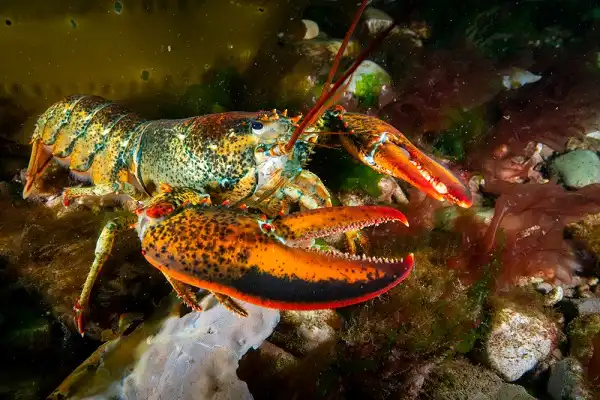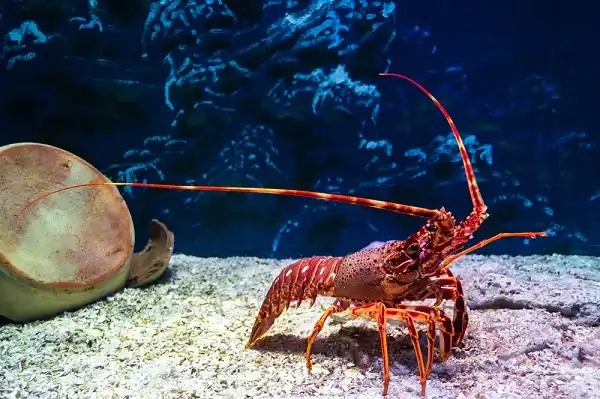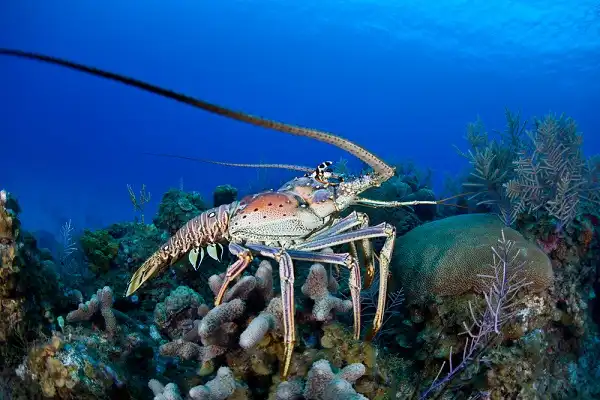In the deep, dark depths of the ocean lurks a mysterious creature known as the lobster. These creatures are strange and fascinating and have long been the subject of speculation and myths. What do we really know about them? Let’s take a closer look at these curious creatures of the deep.

Lobster Description
Lobsters are a type of crustacean that lives in the ocean. They have eight joint legs, two large claws, and a hard outer shell. The shells of lobsters come in various shades of red, green, blue, brown, and yellow. Lobsters mate by performing an elaborate courtship ritual that involves rubbing their antennae together and waving their claws in a certain pattern. They typically lay eggs in the springtime and these hatch into larvae known as ‘zoaea’. After hatching, zoaea undergoes several stages before reaching adulthood and transforming into full-grown lobsters with hard shells. Lobsters have long been sought after for their meaty texture which makes them popular in cooking around the world from North American dishes like lobster rolls to French dishes like Bouillabaisse. In addition to being enjoyed in meal preparations, lobsters are important members of many aquatic ecosystems providing shelter to other marine life as well as helping to keep the water clean by consuming organic debris on the seafloor.
Lobster Habitat
Lobsters can be found in a variety of aquatic habitats including shallow coastal waters, coral reefs, estuaries, and even deeper parts of the ocean. They are typically quite territorial and will defend their space from intruders. Lobsters build burrows or shelters to protect themselves from predators and provide an environment for mating. These burrows can be up to 5 feet long and over a foot deep! Lobster populations are highly dependent on their habitat; if the water quality is poor or the area is too crowded with other lobsters, they may struggle to survive.
Therefore it is important that we do our best to protect these environments from pollution so that the lobster population remains healthy and robust. Lobster migrations also play an important role in maintaining healthy populations as they travel between different aquaculture areas throughout the year in search of food and better breeding grounds. During periods of extreme cold or drought, some species of lobster will migrate further down into deeper waters where temperatures are more stable.
Lobster Diet
Lobsters are omnivorous creatures and have varied diets depending on their habitat. In addition to scavenging prey such as crabs, clams, mussels, fish, and worms, they also feed on small plants such as seaweed and algae growing along the ocean floor. To find food, lobsters will use their sense of smell (antennae) to detect sources from great distances and use their claws to dig through sand and mud in search of prey. The lobster diet should be carefully monitored so that it does not become too rich in certain nutrients like fats or proteins which can lead to long-term health problems for the crustaceans. Lobsters also need plenty of fresh water in order to stay hydrated and healthy. Therefore, when keeping these creatures in captivity it is important to provide them with ample amounts of clean water that has been treated with special aquarium salts designed specifically for crustaceans.

Lobster Size
Lobster size can vary significantly between species and even within a single species depending on the environment in which they live. Generally speaking, lobsters are among the largest of all crustaceans with some species measuring up to 3 feet in length and weighing over 25 pounds. The American lobster is one of the most common species in North America and typically reaches lengths between 7-10 inches (18-25 cm) although some specimens can grow much larger than this. While the female lobsters tend to be larger than their male counterparts, the difference is relatively small. Lobsters have been known to reach impressive sizes with some examples even exceeding 10 feet and weighing nearly 45 kilograms! These animals can often live for many years, with some estimates ranging up to 100 years for certain individuals, making them one of the longest-living invertebrates on earth.
Lobster Lifespan
The lifespan of a lobster can vary greatly depending on the species and environment in which they live. In general, most lobsters will live for 3-5 years but some species have been known to make it to 15 years or more. For example, American lobsters are usually thought to have a lifespan of up to 10 years while European lobsters may live up to 15 years or longer. Lobster age is difficult to determine due to their hard exoskeleton that does not show signs of wear and tear from the passing years like other animals.
However, some scientists have developed methods for aging lobsters by counting annuli, or rings, on their rostrum (the pointy bit in front of their head). Each annulus represents a full molt cycle since hatching from an egg; thus counting these can give an indication as to how old the lobster is. In addition, the size and weight of a lobster can also be used as an indicator of its age. Aside from natural aging processes, there are other factors that can influence the lifespan of a lobster such as predators or disease. Overfishing has had significant impacts on global populations due to commercial fishing practices in many areas; however, this has become less pervasive with the introduction of sustainable fishing methods being employed by fisheries all around the world.
Lobster Behavior
Lobster behavior is characterized by its ability to use its powerful claws to defend itself from predators, pinch prey, and break open hard shells. It also uses its antennae to detect movement in the surrounding environment and assess potential threats that may be lurking nearby. During times of danger, lobsters will instinctively back into the safety of their dens or burrows to hide from predators. Due to their size and strength, lobsters have few natural predators in the wild which can make them quite bold when searching for food; however, it’s important to note that they are still vulnerable because of their relatively slow speed compared with most other aquatic creatures.
This has led some species of lobster (such as Australian Rock Lobsters) to develop a special type of swimming technique called ‘lobstering’ which involves using their long antennae like oars in order to increase speed when needed. During mating season, male lobsters become particularly aggressive towards one another as they compete for access to females; during these times it isn’t uncommon for males to suffer serious injury due to claw battles between rivals vying for dominance.

Lobster Speed
Lobster speed is a fascinating and often overlooked aspect of their behavior due to the fact that they are typically slow-moving creatures. While it is true that lobsters move at a relatively leisurely pace when searching for food and navigating their environment, they can actually reach impressive speeds under certain conditions. The fastest recorded speed of a lobster was clocked at 25 mph (40 km/h) while the average speed of a lobster tends to be closer to around 4 mph (6-7 km/h). This means that lobsters can move more than six times faster than humans in order to evade predators or reach potential food sources quickly.
Lobster Hunting
Lobster hunting is a popular activity for seafood enthusiasts and commercial fishermen alike. Lobsters can be found in all of the world’s oceans, but are most abundant along the North American coastlines stretching from Canada to Mexico. For recreational lobster hunters, the best time to hunt for these crustaceans is typical during the summer months when water temperatures are higher and lobsters are more active.
Fishery regulations and size limits should always be checked before embarking on any search for lobsters as these restrictions can vary widely from state to state. When hunting for lobsters, it is important to keep an eye out for tell-tale signs such as their antennae poking out of holes or crevices in rocks, or by using special traps designed specifically for catching them. Traps come in various shapes and sizes and usually consist of a baited chamber with an opening that allows lobsters to enter but not escape easily once they have entered inside.

Conclusion
Lobsters are fascinating creatures with a variety of behaviors and adaptations which make them incredibly good swimmers, capable of reaching impressive speeds when needed. Furthermore, lobster hunting can provide an excellent source of seafood for both recreational enthusiasts and commercial fishermen alike, however, it is important to know the regulations as well as proper cleaning and preparation methods in order to ensure a safe and enjoyable experience while harvesting these crustaceans.
Frequently Asked Question


